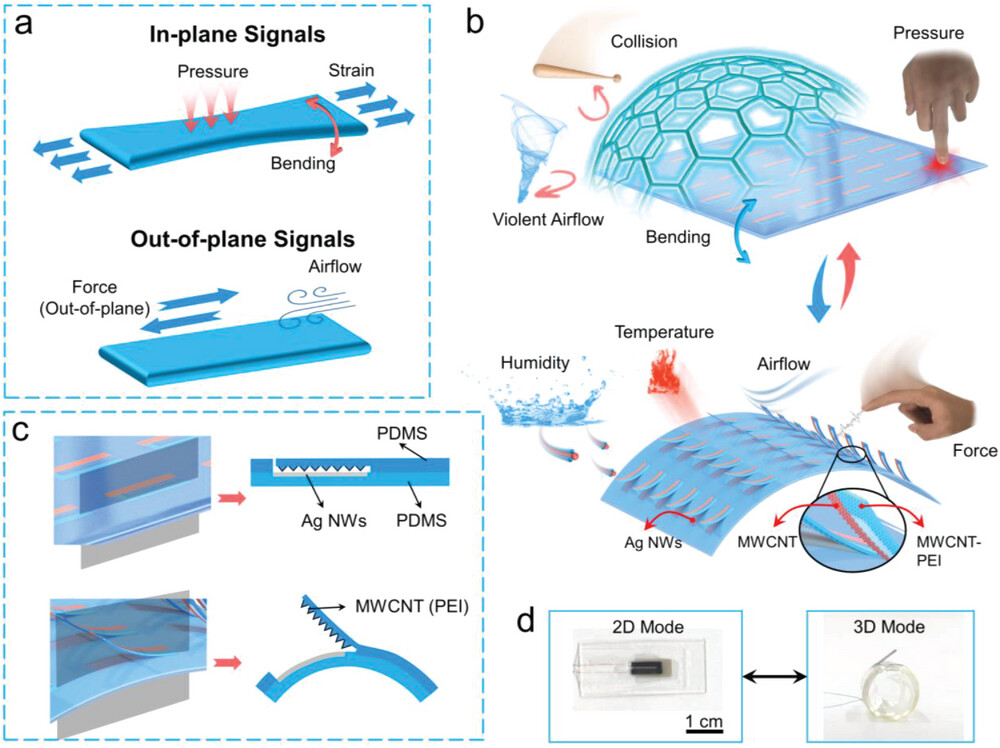| Feb 23, 2024 | |
Flexible sensor uniquely mimics complex touch and perception of human skin |
|
| (Nanowerk Spotlight) Our skin endows us with a profoundly multifaceted sensory awareness unmatched in machines. Human touch conveys intricate patterns of pressure, thermal flow and subsurface textures. It simultaneously maps moisture, contours and minute disturbances in the air. This combination enables astounding environmental comprehension through the body’s flexible, bidirectional sensor grid. Electronic skins (e-skins) that mimic somatosensation have long tantalized engineers. However major barriers have constrained e-skins from achieving the perceptual range of natural skin. | |
| Most existing e-skins demonstrate acute pressure sensitivity for applications in soft robotics and medical monitors. Some microfluidic versions also crudely estimate textures and appendage movements. However, a persistent challenge has been enabling e-skins to fully interact with 3D space. Without out-of-plane force detection, thermal integration and airflow mapping, electronic skins remain isolated from the rich multidirectional contexts that make touch such an informative sense for organisms. | |
| Some prior attempts at 3D tactile electronic perception employed fixed upright sensor structures inspired by the microvibrissae of cats and rodents. But these so-called “e-whiskers” operate too differently from flexible e-skin membranes to replicate our skin’s mechanisms. They also do not match skin’s moisture sensitivity or ability to locally map pressures across curved surfaces. Despite intense interest in e-skins for emerging technologies, researchers have hit stubborn walls expanding these devices’ environmental awareness to approach natural somatosensation. | |
| Now, a research team led by Professor Jian-Wei Liu reports a “stretchable biomimetic multimodal receptor” (SBMR) with unprecedented capabilities for artificial tactile sensing (Advanced Materials, "Biomimetic Multimodal Receptors for Comprehensive Artificial Human Somatosensory System"). | |
| Their design elegantly mimics the feather control capabilities of hummingbirds to switch an e-skin receptor unit between 2D and 3D modes on demand. The team’s novel combination of kirigami film engineering techniques and multifunctional conductive carbon nanotubes enables both planar and vertical force detection, airflow sensing, humidity measurement, and temperature monitoring within one low-cost sensor. | |
 |
|
| Mechanical design of the stretchable biomimetic multimodal receptor (SBMR). a) Diagram that shows the in-plane and out-of-plane signals. b) Various sensing modalities for 2D and 3D structures. c) The cross-sectional views of 2D and 3D modes. d) The optical images of the SBMR in different modes. (Reprinted with permission by Wiley-VCH Verlag) | |
| The SBMR device contains specialized micro pyramid and nanomaterial components constructed on thin film surfaces. By actuating simple stretch or bend motions, researchers can transform the flexible SBMR unit between flat e-skin and protruding e-whisker configurations. In e-skin mode, the SBMR senses expected pressure and strain signals from planar contact thanks to its micro-structured piezoresistive conductive layer. However, bending the base film also causes the sensor’s whisker tip to pop vertical, switching dynamically into the 3D architecture needed for unprecedented out-of-plane stimulus measurements. | |
| Outstretched, the SBMR leverages its whisker-like aspect ratio to achieve remarkable sensitivity, detecting minute perpendicular forces as slight as 25 micronewtons – less than the weight of a single grain of sand. The vertical orientation also enables the unit to sense dynamic wind pressures and airflows across its surface. | |
| In addition, the team’s specially engineered thermoelectric conductive materials facilitate accurate thermal and humidity measurements from the 3D-extended configuration. Combined together, these multidirectional force, flow, and environmental detections offer a comprehensive tactile and environmental survey impossible through any previous e-skin techniques. | |
| Another powerful new capability of the SBMR is correctly distinguishing contact forces from pure temperature signals – a difficult challenge for both natural and artificial skin devices. The researchers harnessed unique thermal electricity properties in their sensor compounds to generate identifying voltage spikes only when the SBMR physically touches warm objects. This clever bioinspired mechanism provides an unambiguous temperature vs. pressure differentiation lacking in all prior e-skins. | |
| Remarkably, Liu’s team further demonstrates that an array of their SBMR units can be flexibly integrated onto the joints of a robotic hand to replicate the versatility and sensitivity of human fingertips. As the artificial fingers bend, the sensors automatically transform between adaptive 2D and 3D modes to supply the robotic grasp with precise, real-time tactile feedback for handling objects. The researchers also highlight potential applications spanning biomedical supports, human augmentation, hazard detection, and monitoring automation. | |
| Overall, this research represents a breakthrough in mimicking both the compliance and environmental adaptivity of natural skin for electronics. The prototype SBMR device introduces world-leading multifunctional capabilities and responsiveness dramatically advancing the boundaries of artificial tactile sensing. In the future, the pioneering reconfigurable e-skin system could perceptions for prosthetics, robots, vehicles, smart infrastructure monitoring, and many emerging technologies relying environmental comprehension. | |
 By
Michael
Berger
– Michael is author of three books by the Royal Society of Chemistry:
Nano-Society: Pushing the Boundaries of Technology,
Nanotechnology: The Future is Tiny, and
Nanoengineering: The Skills and Tools Making Technology Invisible
Copyright ©
Nanowerk LLC
By
Michael
Berger
– Michael is author of three books by the Royal Society of Chemistry:
Nano-Society: Pushing the Boundaries of Technology,
Nanotechnology: The Future is Tiny, and
Nanoengineering: The Skills and Tools Making Technology Invisible
Copyright ©
Nanowerk LLC
|
|
|
Become a Spotlight guest author! Join our large and growing group of guest contributors. Have you just published a scientific paper or have other exciting developments to share with the nanotechnology community? Here is how to publish on nanowerk.com. |
|
